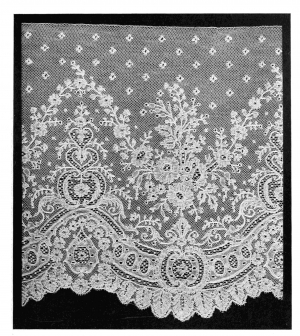The definition of lace used here is that lace is a textile patterned with holes that are created by the manipulation of threads. In particular, lace needs to have four essential features: (a) it must be made of one or more threads, (b) there must be holes, (c) the holes must be made by a particular and deliberate movement of the threads, and (d) the holes must form an essential part of the design and not have an incidental role.
The precise nature of the special movement, i.e. the technique used, is of importance in identifying or classifying a particular example of lace. Basically, ten main techniques can be distinguished: (a) Appliqué net laces; (b) Embroidered laces; (c) Embroidered net laces; (d) Needlepoint laces; (e) Tape laces; (f) Bobbin laces; (g) Interlaced laces; (h) Knotted laces; (i) Looped laces; (j) Mixed laces. Within each of these ten forms, there are many different types and variations, all of which can come under the general umbrella heading of lace.
Of the above mentioned ten diferent main types of lace, the appliqué net laces (a), embroidered laces (b), embroidered net laces (c), needlepoint laces (d), and tape laces (e), can be classified as decorative needlework.
See also the TRC Needles entry on a Schematic survey of lace types.
Source: EARNSHAW, Pat (1984). A Dictionary of Lace, Aylesbury: Shire Publications Ltd, pp. 91-92.
Digital source of illustration.
GVE

